Antimicrobial cutting boards are one of the easiest upgrades I’ve made in my kitchen that actually improve hygiene without adding extra work. I use them because they help prevent bacterial buildup during food prep, especially when switching between raw meat and fresh produce. They’re a quiet safety net — working in the background while I focus on flavor, timing, and, occasionally, not burning dinner.
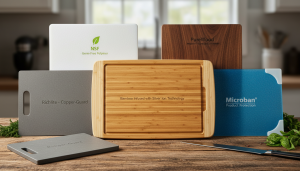
I’ve always believed that a clean prep surface is just as important as the ingredients themselves. You can craft the most beautiful meal, but if the cutting surface isn’t sanitary, the effort loses its purpose. These boards give me peace of mind, reduce cross-contamination risk, and make cleanup a lot simpler. That’s what made me stick with them in my daily cooking routine.
Here’s what I’ll cover in this post:
-
What antimicrobial cutting boards are and why they matter
-
Why I personally rely on them
-
The best materials I use in my kitchen
-
My favorite boards and how I use them
-
Cleaning and maintenance tips that actually work
-
Common myths that I want to debunk
-
A simple guide for choosing the right board
-
Answers to frequently asked questions
What Are Antimicrobial Cutting Boards?
Simply put, an antimicrobial cutting board is designed to resist bacterial growth. Unlike regular boards, they’re made from materials that help keep germs from multiplying. Some rely on natural properties, like bamboo, while others include additives like silver or copper ions.
I’ve used both types in my kitchen. While they don’t magically eliminate germs, they make it harder for bacteria to thrive. For someone who cooks regularly, this difference is noticeable — less odor, less risk, and more confidence while preparing food.
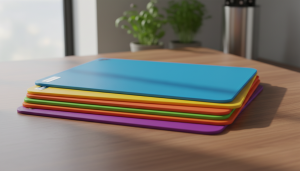
Why I Rely on Hygienic Cutting Boards
A few years ago, I made the rookie mistake of cutting raw chicken on a regular wooden board and then immediately chopping vegetables on the same surface. Let’s just say I learned the hard way about cross-contamination. Since then, I’ve been intentional about using boards that resist bacteria.
Here’s why I’ve stuck with them:
-
Odor and stain resistance: They don’t hold smells from onions or garlic.
-
Cross-contamination protection: I feel safer switching between raw meat and fresh produce.
-
Ease of cleaning: They handle daily washes without warping or discoloring.
For me, a good board isn’t just a tool — it’s a piece of kitchen insurance. Knowing my prep area is safer allows me to focus on cooking, not cleaning anxiety.
The Best Materials for My Cutting Boards
I’ve tried every material over the years. Some wear out too quickly, while others become kitchen staples. Here’s what I consistently recommend based on performance and hygiene.
Plastic (HDPE and Polypropylene)
Plastic boards often get a bad rap, but high-quality HDPE boards are excellent. They’re non-porous, which keeps bacteria from hiding in tiny grooves, and they’re dishwasher-safe.
I use plastic boards primarily for raw meats and fish. The best ones also have non-slip edges, which is great because I’ve had my fair share of chasing a sliding board mid-chop.
Bamboo Boards
Bamboo has natural antibacterial properties, and it’s one of my go-to materials for fruits, vegetables, and bread. It’s lightweight and eco-friendly, though it does need a bit of oiling now and then to prevent cracking.
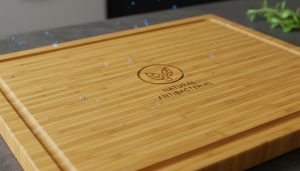
A bamboo board also looks great on the counter, which makes me happy every time I reach for it.
Rubber and Composite Boards
These dense, knife-friendly boards are common in professional kitchens — and for good reason. They’re durable, resist staining, and easy to sanitize. I once tested a composite board for a friend’s restaurant, and it felt satisfying to use without dulling knives.
The best part? Even messy ingredients like beetroot don’t leave a permanent mark.
Metal-Infused or Specialty Boards
Some modern boards feature silver or copper ions embedded in their surfaces. They’re pricier but very effective for high-traffic kitchens or heavy meat prep.
I tested a titanium-infused board recently. It was sleek, cleaned easily, and performed flawlessly — handling everything from salmon to strawberries without retaining odors.
My Top Antimicrobial Cutting Board Picks
I often get asked which boards I use and recommend. Here are my top choices:
ChopChopUSA Antimicrobial Board
This board is my daily driver. It’s durable, dishwasher-safe, and has soft-grip edges. After over a year of regular use, it still looks almost new.
Joseph Joseph Cut & Carve
Ideal for meat lovers. Its raised edges trap juices and make cleanup a breeze. I appreciate it when I’m prepping chicken or beef — fewer spills, fewer headaches.
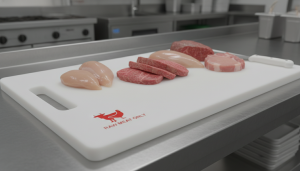
Totally Bamboo Three-Piece Set
I use one for veggies, one for bread, and one exclusively for raw proteins. It keeps things organized and hygienic.
And if you’re looking for more clean food prep options, you might enjoy my Best Food Dehydrator review — it pairs perfectly with healthy snacks and meal prep.
How I Keep My Boards Clean
Even antimicrobial boards require care. I follow a simple routine:
-
Wash after each use with mild soap and warm water.
-
Deep clean weekly using white vinegar or diluted lemon juice.
-
Dry thoroughly to prevent moisture buildup.
-
Oil bamboo boards every few weeks with food-grade mineral oil.
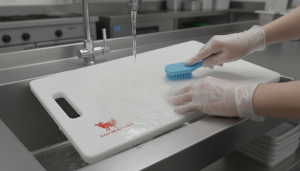
When plastic boards get heavily scored, I replace them. Deep cuts harbor bacteria that even antimicrobial properties can’t reach. A fresh board is worth the investment.
Common Myths About Hygienic Cutting Boards
Let’s clear up some misconceptions:
Myth #1: “Antimicrobial boards don’t need washing.”
False. They resist bacterial growth but still require regular cleaning.
Myth #2: “Wood is unhygienic.”
Not true. Bamboo and maple naturally resist microbes; they just need proper care.
Myth #3: “Plastic is always safer.”
Plastic works well, but deep grooves can hide bacteria. Replace scored boards regularly.
Myth #4: “One board is enough.”
Separate boards for raw and cooked foods prevent cross-contamination — simple but effective.
Choosing the Right Board for Your Kitchen
Here’s my personal approach:
-
Cooking habits: Raw proteins? HDPE or silver-ion boards are best.
-
Aesthetic preference: Love natural materials? Bamboo adds style.
-
Maintenance tolerance: Dishwasher-safe options for convenience.
-
Kitchen space: Stackable, thinner boards are ideal for small kitchens.
I’ve seen people buy fancy wooden boards that they end up storing because they’re too high-maintenance. Use what fits your routine — that’s the key.
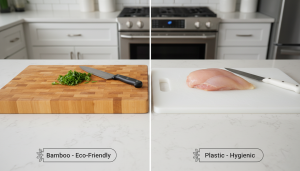
Frequently Asked Questions
Q: Are antimicrobial boards completely germ-free?
Not entirely. They just slow bacteria growth.
Q: Can I put them in the dishwasher?
Plastic and metal-infused boards are usually fine. Bamboo or wood should be hand-washed.
Q: How long do they last?
With proper care, 2–3 years for plastic or metal boards; bamboo can last longer if oiled and maintained.
Q: Which is safer — plastic or bamboo?
Both are safe with proper use. Bamboo is naturally resistant; plastic is easy to sanitize.
Q: Should bamboo boards be oiled?
Yes, roughly every two to three weeks for regular use.
Final Thoughts
For me, a cutting board is more than a tool — it’s a daily safeguard. Switching to a hygienic board changed my kitchen routine for the better. Fewer germs, easier cleanup, and more confidence while cooking.
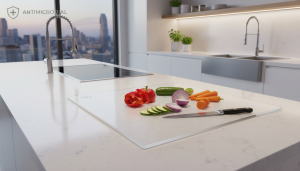
If you cook regularly, investing in a high-quality board is worth it. It’s simple, practical, and makes your kitchen safer. Whether you’re prepping a quick salad or a big family meal, the right board is a small change with a big impact.
Cooking should be about flavor and creativity — not stress over germs. And honestly, the fewer invisible guests at dinner, the better.